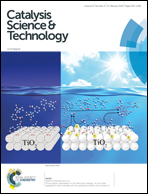Synergistic effects and mechanism of a non-thermal plasma catalysis system in volatile organic compound removal: a review
Abstract
Non-thermal plasma catalysis with high efficiency, high by-product selectivity and superior carbon balance is one of the most promising technologies in the control of volatile organic compounds (VOCs). Non-thermal plasma catalysis can be subdivided into three types: continuous operation in plasma catalyst (CIPC) system, sequential operation in plasma catalyst (SIPC) system and post plasma catalyst (PPC) system. In this review, a comprehensive discussion on the synergistic mechanism of the CIPC, SIPC and PPC systems is provided. For CIPC, the introduction of catalysts changed the discharge behavior and generated new active species. Plasma discharge modified catalyst surfaces were summarized. The behavior and mechanism of catalyst adsorption and surface reactions within a plasma reactor and plasma oxidation in SIPC were discussed. For PPC, the performance of the plasma modified gas composition and temporarily activated catalysts were analyzed. In addition, the by-product inhibition by catalysts was also discussed. Moreover, the synergistic effects of the plasma and catalysts of the three systems on VOC destruction were critically reviewed. Based on these studies, the catalyst characteristics suitable for the CIPC, SIPC and PPC systems were summarized. Finally, the outlook on non-thermal plasma catalysis coupled systems in VOC control was proposed. It can be reasonably anticipated that this review is meaningful for deepening our understanding of the fundamental scientific principles regarding the catalytic oxidation of VOCs in non-thermal plasma catalysis systems, providing valuable and feasible references for researchers and designers on the efficient reduction and control of VOCs.



 Please wait while we load your content...
Please wait while we load your content...